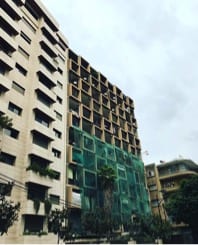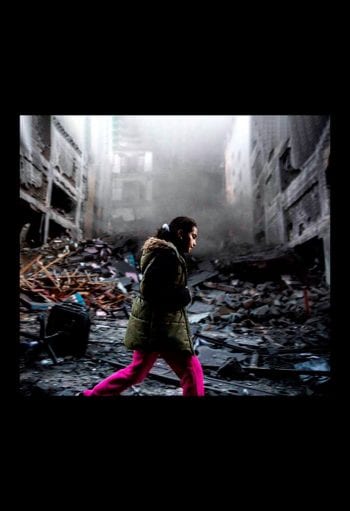A Half Full Beirut
By Samia Khan, on 15 March 2019
One person is forcibly displaced every two seconds in the world and over twenty-five million people are now refugees worldwide as result of conflict.[1] They journey seeking settlement in a place where they can secure livable circumstances.
Humanitarian literature on refugees is clear to distinguish the types of protection at play; UNHCR for example determines that the three ways to protect a refugee is to rehabilitate, repatriate or resettle.[2] A majority of refugees in the Arab world who have fled failed states and armed conflicts have resettled in neighbouring countries and still continue to do so.[3] Throughout the past 70 years, Palestinian refugees have been through several phases of vulnerability and displacement, affected by their immedeate struggles, but also by a shifting set of tensions: deterritorialisation, urban pressures and geo-politics. Arab host countries such as Jordan, Lebanon and ‘temporary’[4] camps set along the West bank, East Jerusalem and Gaza strip[5] lack the proper infrastructure and regulatory frameworks to integrate refugees which complicates resettlement processes. With the arrival of refugees as a result of the Syrian crisis of 2011[6] existing refugee camps and displaced communities in host countries such as Lebanon started to overflow by a population of over another million[7], and reached a crisis point that needed immediate attention.
Recent events show how political unrest impact the plight of refugees. Lebanon was without a stable government for nearly two and a half years before starting to form cabinet structure very recently.[8] This political unrest suspends efforts for urban planning which tackles the influx of refugees. The economic infrastucture is still recovering from the conflicts the country witnessed, particularly the 1975 – 1990 civil war and the armed conflict of 2006 with Israel. Though efforts were made for public and social reconstruction, economic growth was insufficient and large areas were bought by private sector for real estate development to help the Lebanese economy thrive.[9]
The extended political crisis resulted in an eminent economic downfall. Tax reforms, suspension of bank loans and Lebanon’s debt of $81 billion being the third largest in the world, soared real estate prices.[10] According to a recent conversation with a local activist, Elza Seferian, “ the ‘unliveability’ of Beirut is like a Pandora’s box for me. The price of renting a room in Beirut is as costly as Paris. Affordable housing is scarce.”.
With refugees from neighbouring countries moving in at an exponential pace, existing refugee settlements such as those for example in Sabra, Shatila and Akkar are overpopulated and in dismal living conditions.[11] The lack of space in temporal arrangements pushes refugees to the capital to rent spaces in tower buildings, that were abandoned by private sector initiatives. ‘A half full Beirut’ is a notion that is derived from the complex situation in Beirut where private sector developers have run out of money and are unable to complete real estate projects[12] leaving Beirut’s skyline half empty. However, these abandoned spaces have been vacant on the formal market for years, yet are rented out to refugees albeit on extortionate rates[13], hence are more often than not ‘half full’.

Refugee laundry seen hanging outside of abandoned building project
half inhabited by refugees in Hamra district, Beirut
Photo courtesy: Elza Seferian, 2017
Beirut is lacking in affordable housing for middle-income and this historical issue for locals has now extended and become part of the refugee experience.[14] This shows a fracture in the market. With the relocation of refugees from camps to capital, they become an active part of the urban population and drivers of the formal and informal real estate market.
State led initiatives to mitigate refugee housing issues has been quite limited in Lebanon. It is one of the countries that has not signed the 1951 International Convention for Refugees which was established in by UNHCR. The convention’s core principle “asserts that a refugee should not be returned to a country where they face serious threats to their life or freedom…”.[15] The civil society, though unstructured, is the major agency of support for refugees alongside non governmental organizations.[16] A detailed mapping of Civil Society Organizations and their scope in Lebanon can be found here: https://eeas.europa.eu/archives/delegations/lebanon/documents/news/20150416_2_en.pdf
Refugees rely on housing arrangements made by CSOs and NGOs such as ACTED[17], URDA[18], ANERA[19], DRC[20] and more.[21] They are ready to take on any opportunity for housing they can secure. Without formal paperwork, documentation or legal rights, refugees become susceptible to exploitation. The real estate black market thrives on premium rental rates, making refugees susceptible to forced evictions and other forms of abuse that pose no repercussions on the landlords.[22]
Though private sector developments are abandoned, they stand on land bought by private companies from the government, stripping the government from authority over majority of Beirut’s land or the real estate projects. In light of these conditions, the following conclusions can be considered:
- Government can strenghten legal frameworks and negotiate alternative uses for abandoned spaces to provide more liveable urban solutions to locals and refugees
- Since CSOs and NGOs possess the role of primary support to refugees and low income households with housing, agency can be established between the private sector and civil society to liaise with discontinued developments and create affordable housing schemes
- Refugee integration schemes can be enhanced by CSOs and NGOs by creating a rigid framework of lease documentation to closely monitor the resettlement process
There is a pressing need for housing in Beirut yet an abundance of uninhabited spaces. Perhaps if the underlying opportunity within these spaces was recognized and organized, a solution could arise for the housing crisis that affects millions.
Samia Khan is a graduate of the MSc Building and Urban Design program at the DPU
Additional Resources:
http://portal.unesco.org/en/files/27465/11162415081UNDP_NGO1.pdf/UNDP%2BNGO1.pdf
https://openmigration.org/en/analyses/syrian-refugees-in-lebanon-still-reluctant-to-go-home/
https://germanwatch.org/sites/germanwatch.org/files/publication/8889.pdf
https://data2.unhcr.org/en/documents/download/45502
http://aub.edu.lb.libguides.com/c.php?g=276479&p=1843038
http://website.aub.edu.lb/ifi/Documents/op_ed/20190208_sjc_op_ed.pdf
http://reporting.unhcr.org/node/2520
https://www.alnap.org/system/files/content/resource/files/main/20150907-noplacetostay.pdf
http://www.undp.org.lb/communication/publications/downloads/intgov_en.pdf
https://www.daleel-madani.org/civil-society-directory/cooperative-housing-foundation
[1] https://www.unhcr.org/figures-at-a-glance.html
[2] https://www.unhcr.org/50a4c17f9.pdf
[3] https://carnegieendowment.org/2017/03/29/refugees-and-displacement-in-middle-east-pub-68479
[4] Refugee camps are often thought of as a temporary solution under the assumption that refugees will one day return to their home countries. These camps have now evolved to urban slums as the influx in the Middle East increases.
https://www.ft.com/content/b27283ce-ed29-11e8-8180-9cf212677a57
https://unhabitat.org/wp-content/uploads/2015/01/From-Refugee-Camps-to-Urban-Slums.pdf
[5] https://www.unrwa.org/palestine-refugees
[6] https://www.britannica.com/event/Syrian-Civil-War
[7]https://www.researchgate.net/publication/321779706_Syrian_Refugees_in_Palestinian_Refugee_Camps_and_Informal_Settlements_in_Beirut_Lebanon
[8] https://www.economist.com/the-economist-explains/2018/12/21/why-lebanon-struggles-to-form-governments
[9] http://www.lb.undp.org/content/dam/lebanon/docs/Operations/LegalFramework/UNDP%20Lebanon%20PS%20Strategy.pdf
[10] https://www.apnews.com/d7faca02c8024f8da57ffa6987500e2d
[11] https://www.thenational.ae/world/shatila-s-population-unknown-as-palestinian-refugee-camp-bursts-at-seams-1.178993
[12] https://www.bloomberg.com/news/articles/2018-11-02/beirut-s-ghost-apartments-are-haunting-the-economy
[13] https://now.mmedia.me/lb/en/reportsfeatures/the-refugee-effect-on-lebanese-rent
[14] http://www.executive-magazine.com/opinion/comment/charting-a-path
[15] https://www.unhcr.org/3b66c2aa10
[16] https://www.washingtoninstitute.org/uploads/Documents/pubs/BeyondIslamists-Lebanon-4.pdf
[17] https://www.acted.org/en/countries/lebanon/
[18] http://urda.org.lb/en/details.aspx?ID=1718
[19] https://www.anera.org/where-we-work/lebanon/
[20] https://drc.ngo/where-we-work/middle-east/lebanon
[21] http://joannachoukeir.com/List-of-NGOs-in-Lebanon#.XHKhsZMzaRs
[22] http://www.executive-magazine.com/business-finance/real-estate/renting-on-lebanons-black-market
 Close
Close





